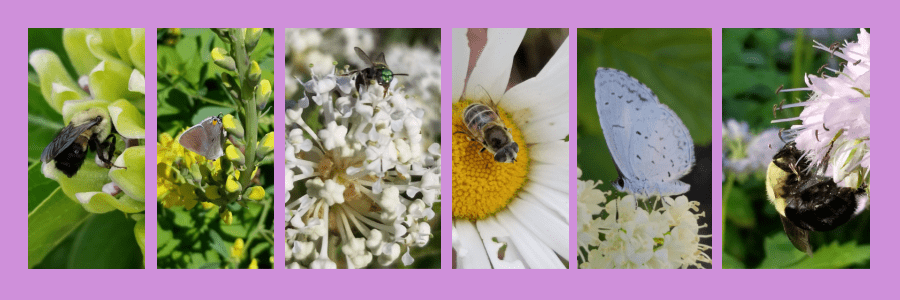For several years now, the trend has been on what to plant for pollinators. This is a two-sided question. What do you think of when planting for pollinators? Do you think about what plants pollinators are attracted to for nectar and pollen, or attracted to as a host plant? We need to think about both things when planning on new plants for pollinators. Because there are so many plants to think about, I am breaking this into 4, 2-month sections, starting with April and May.
What are the pollinators in April and May? The big one of course, is honeybees. Despite being aliens in North America, they are well-adapted to many diverse landscapes. If the outside temperature is above 50 degrees Fahrenheit, you will see honeybees flying around looking for food. So, there needs to be food for them. And the other bees. As well as beetles, moths, butterflies, and other pollinators which you want to attract to your garden.
Why attract pollinators at all? Why is it so important? Besides the fact that pollinators affect the ability of our vegetable and fruit crops to produce, they also help maintain a healthy landscape and ecosystem. If you have lots of insects, especially moths, then you will have lots of birds. It takes more than a birdfeeder with sunflower seeds to keep bird populations high in your neighborhood.
Host Plants for Pollinators
The list for host plants for pollinators is quite extensive. However, if you just plant 1 oak tree, you have already supplied food for more than 500 species of moths and butterflies, not to mention other insects.
What are host plants? Host plants are plants that provide actual insect rearing food. Such as leaves and stems for insect larvae to feed and develop on.
If you plant any of the following 11 species of trees/shrubs, you will be providing food for at least as few as 200 species of moth and butterflies. That is a lot of caterpillars. But do not worry about them eating the trees, for birds and other natural enemies will eat the majority of the caterpillars before they can mature enough to destroy the plants.
Flowering Plants for April Pollinators
April is early spring and it can be difficult to add in plants for pollinators, unless you have room for a lot of flowering trees. Of course, you might be able to add in several redbuds, crabapples, and other flowering trees. Or create a berm with the trees as the center and add perennials and shrubs around them. There are a myriad of ways to add plants to your landscape. Even if you are short on space, many plants and small trees can be put in containers on a patio or deck.
The following list contains plants that provide good nectar and pollen for early spring pollinators in the Central Great Plains.
Where is the Central Great Plains? This region includes Northeast Kansas (from Marysville eastward and Emporia north), Northwest Missouri (Chillicothe west and Sedalia north), and Southeast Nebraska (Grand Island east and Omaha south).
- Redbuds (Cercis canadensis and cultivars)
- Crabapples (Malus species)
- Black Cherry (Prunus serotina)
- Apple cultivars
- Magnolias
- Black chokeberry (Aronia melanocarpa and cultivars)
- Nannyberry (Viburnum lentago)
- Arrowwood (Viburnum dentatum)
- American Plum (Prunus americana)
- Chokecherry (Prunus viginiana)
- Basket of Gold (Alyssum)
- Wood Phlox (Phlox divaricata)
- Pasque flower (Pulsatilla)
- Carolina Lupine (Thermopsis)

Flowering Plants for May Pollinators
We often use the saying of “April showers bring May flowers.” But here in the Central Great Plains, we get the majority of our best flowers in June. However, there are a variety of flowers blooming in May that are great for our pollinators and for our gardens.
- Apple tree cultivars
- American plum (Prunus americana)
- New Jersey Tea (Ceanothus americanus)
- Dwarf Korean Lilac (Syringa meyeri)
- Baptisia cultivars
- Hardy geranium (Geranium species)
- Spider Milkweed (Asclepias viridis)
- Catmint cultivars
- Salvia cultivars
- Penstemon species and cultivars
- Daisy cultivars
- Yarrow ‘Moonshine’
- Amsonia species and cultivars
- Dianthus cultivars
- Candytuft (Iberis)
- Virginia waterleaf (Hydrophyllum virginianum)

Conclusion
Finding and growing flowering plants for pollinators should always start with the basics. Learn what kind of soil you have, your own site microclimates, and your region for growing. Then proceed by looking at the above flowers and see which would work best for your own situation.
Happy planting!




